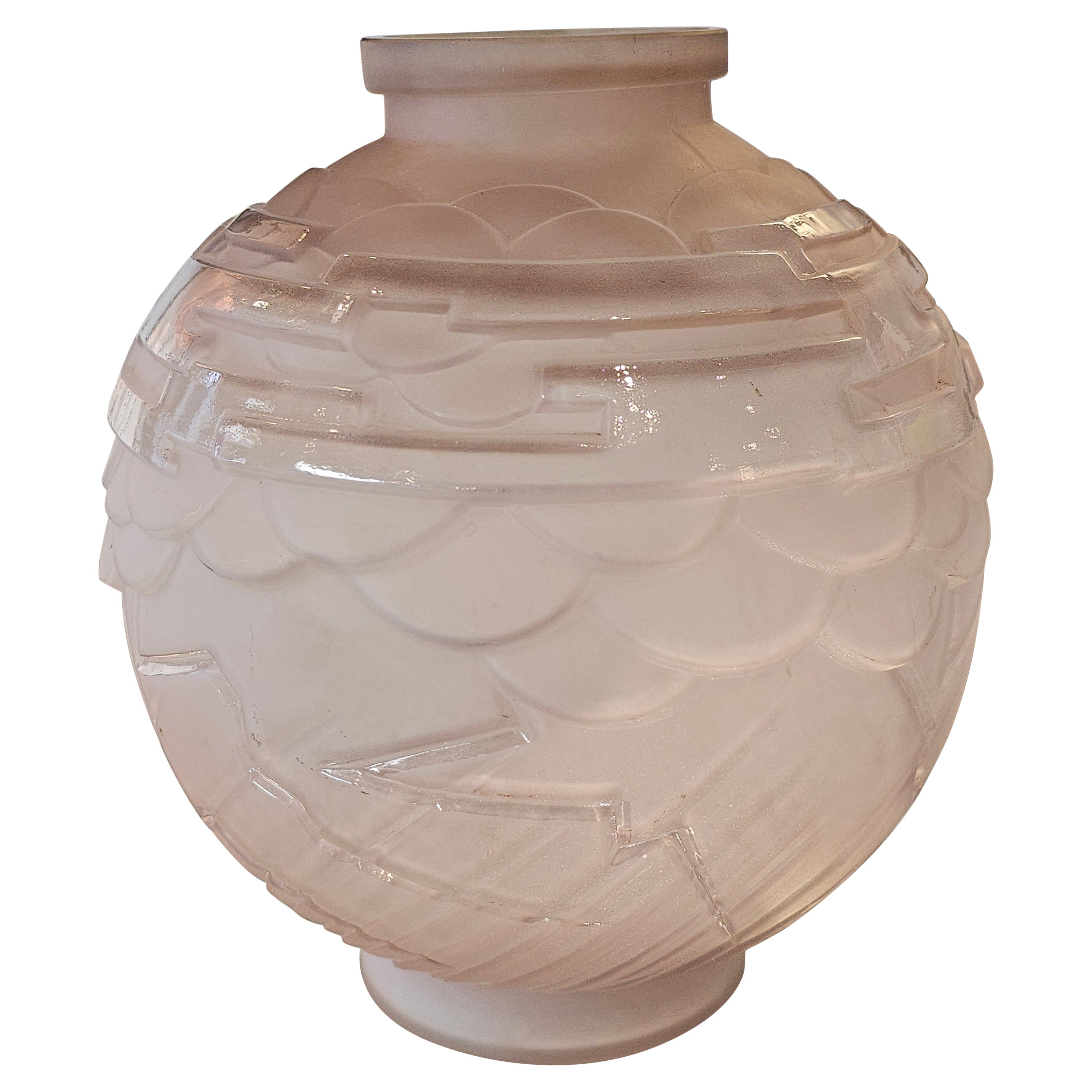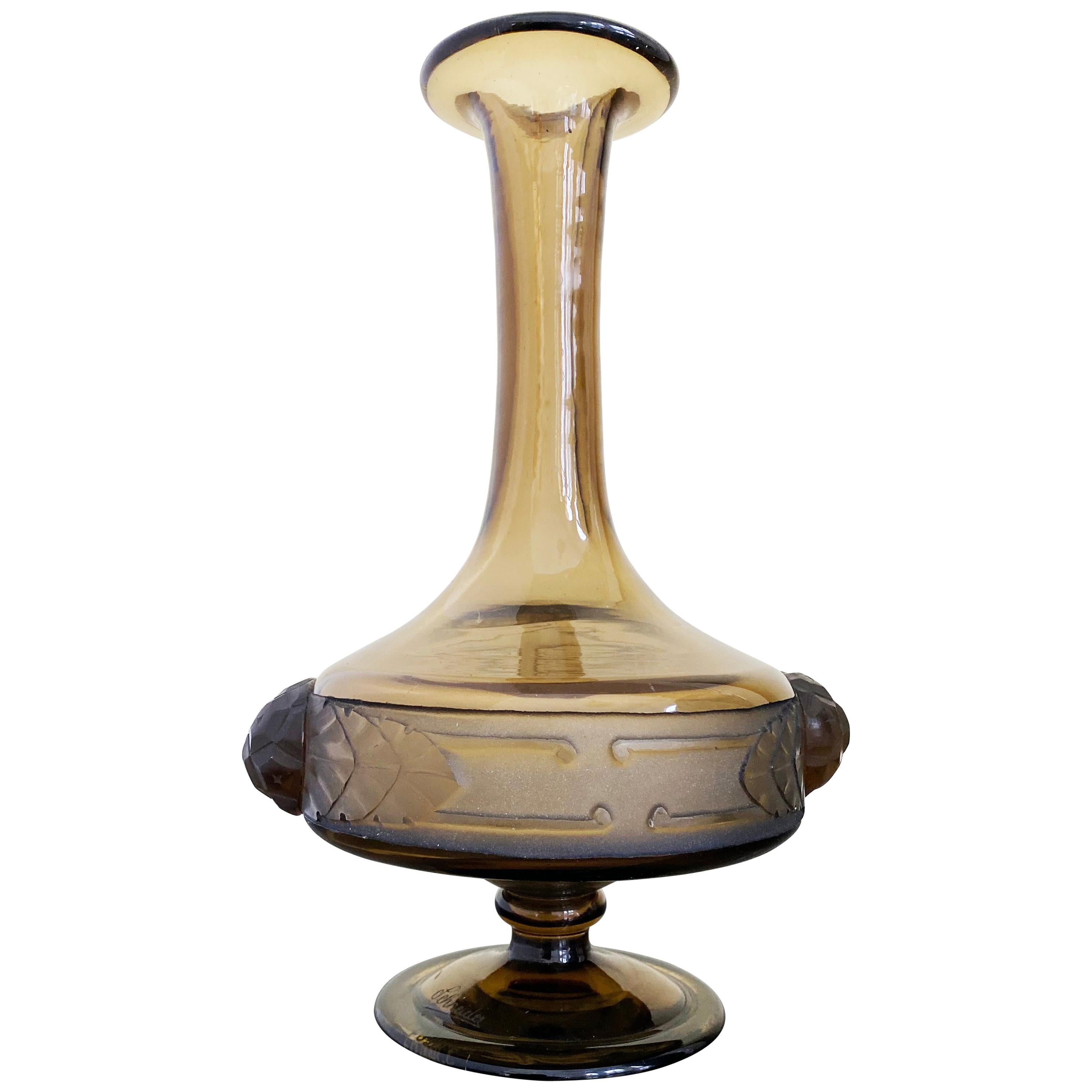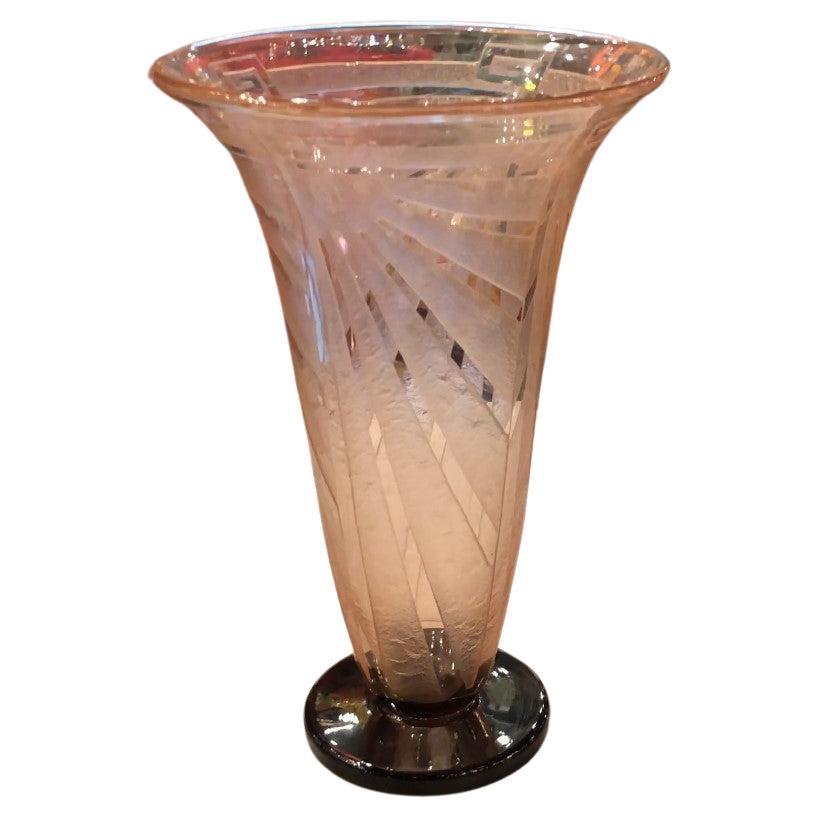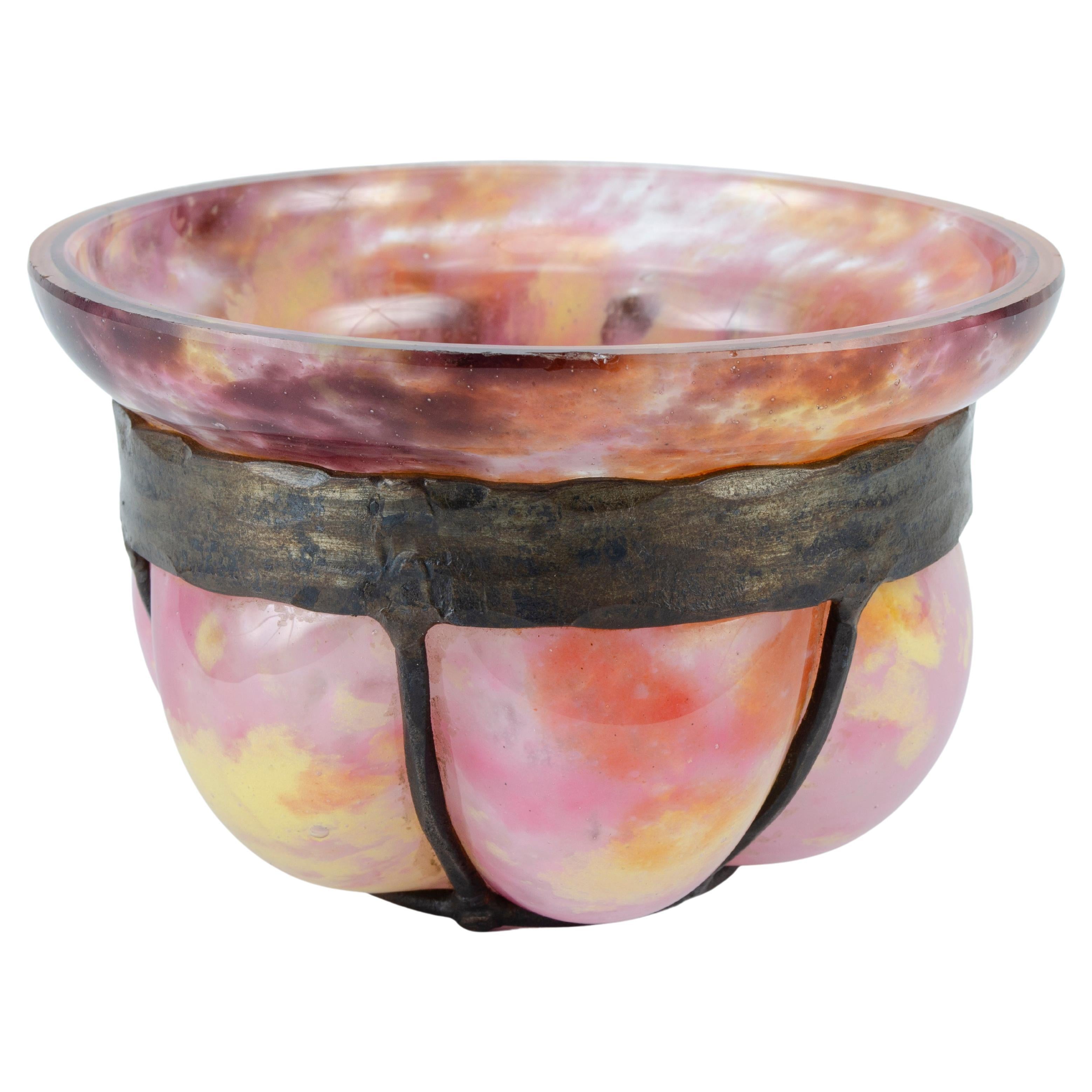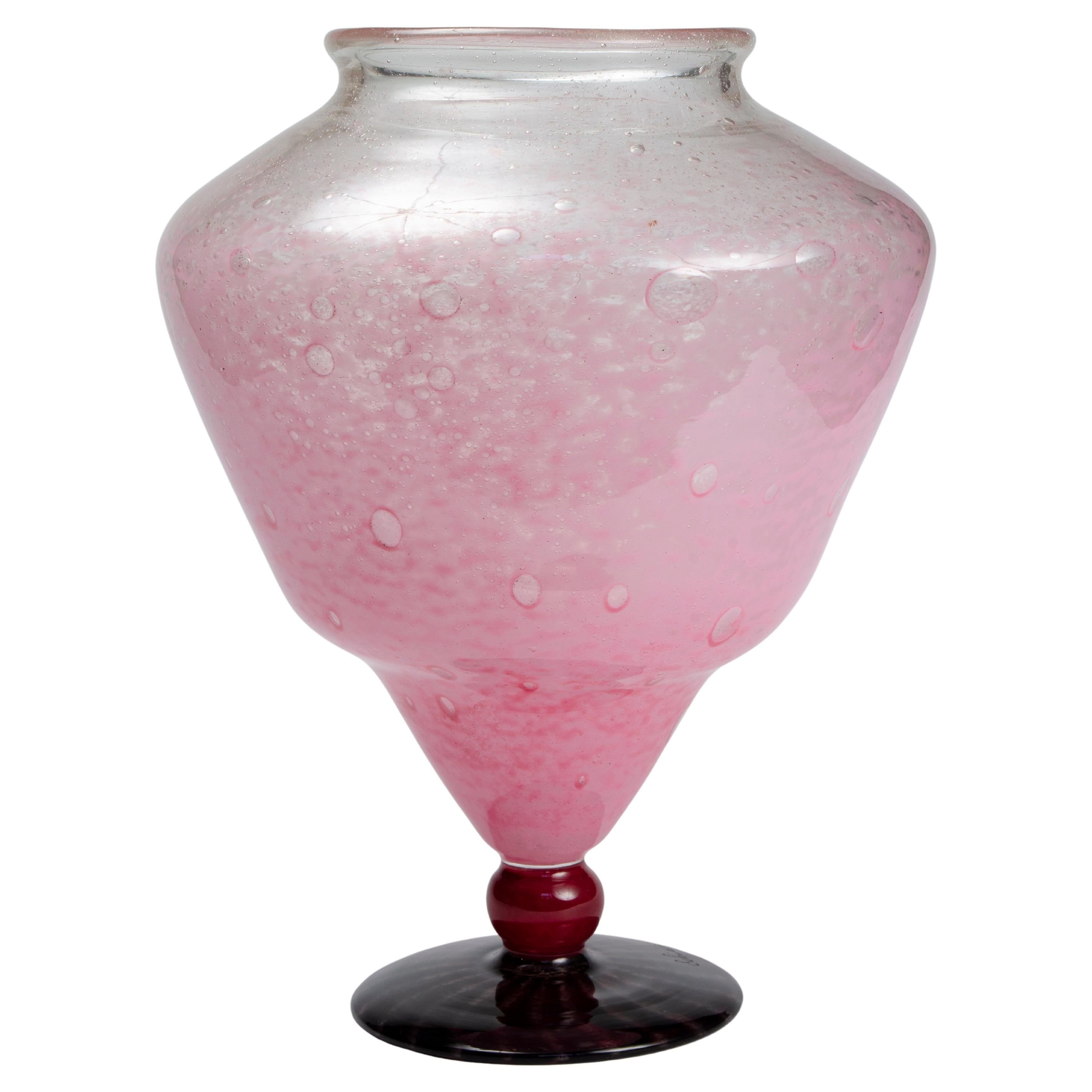Items Similar to Charles SCHNEIDER Large French Art Deco Pitcher Ewer, 1924-1928
Want more images or videos?
Request additional images or videos from the seller
1 of 10
Charles SCHNEIDER Large French Art Deco Pitcher Ewer, 1924-1928
About the Item
French Art Deco pitcher ewer by Charles Schneider, Epinay-sur-Seine (Paris), 1924-1928. Large and heavy pitcher or ewer in mate mottled warmly colored glass. Enamels are applied applied between to layers. Schneider pieces are rare in matte finish. In addition, here, the glass is thick. These two elements bring a virility compensating for the delicacy of the shape. A rare piece with a big personality. Height : 14.6"(37cm), Diameter : 8.7"(22cm). Signed "Schneider" at the bottom (see photo).
Charles Schneider was born in Chateau-Thierry, near Paris, on 23rd February 1881. At an early age he moved with his family to Nancy, the artistic center of France.
His brother, Ernest Schneider (1877-1937), started working for Daum in 1903 as clerk. Charles had started an artistic career and was already active at Daum since 1898. He performed his practical training in the engraving and decorating workshop, but he also took drawing and modelling lessons with Henri Berge. Concurrently, he studied the Ecole des Beaux-Arts in Nancy.
In 1904, he went to the Ecole Nationale des Beaux-Arts in Paris and studied painting and medal engraving. During this period, he made bronze art objects in the pure Art Nouveau style, all signed "CH. SCHNEIDER Nancy". From 1906, he regularly exhibited in the Engraving section of the Salon de la Societe des Artistes Francais and he was twice awarded a prize.
In 1913, the brothers decided to start their own business and bought a small glass factory, specialising in electric light bulbs, in association with a friend Henri Wolf, at Epinay-sur-Seine. This factory was known as ‘Schneider Freres & Wolf’. The new glassworks production started with, among others, a group of about twenty workers enticed away from the Daum manufacture. At the outbreak of the World War I, the firm's activity had to be stopped and the glassworks closed by the end of 1914.
Ernest and Charles were demobbed in 1917 and the factory re-opened under the name "Societe Anonyme des Verreries Schneider". At this time, public taste still favoured the Art Nouveau style, and the factory produced mainly ‘cameo’ glass with floral and animal designs, and vases with applied handles and bubbles. Apart from the introduction of art glass, half of the production was of commercial drinking glasses. In 1918, fire destroyed the studios at Galle and a group of artists went to Schneider’s to continue their production for Galle. This period was of great importance to Charles Schneider because he acquired the technique of ‘marqueterie de verre’ from Galle’s artists. This technique, similar to marquetry in wood, is where the design is carved out of a vase and filled with colored glass.The big black-footed bowls are one of the first types of art glass made by the Schneider factory. These designs give only a partial idea , however, of the variety of bowls of this type that were produced for at least he next six years. During the first period, they had a satinic finish (1918-1921). Later, they were polished to a smooth, brilliant surface.
In this period, Schneider started producing top-of-line pieces with intercalary motifs or with applied patterns requiring a thorough mastery of the execution technique on the part of the glassmaker. Mention should be made of the pieces with wheel-carved patterns, such as the "Raisins noirs" series, and the "Pavots" or "Camelias" medallion series.
Some of the factory's most interesting models during the early period were designed by Gaston Hoffman between 1918 and 1921. His pieces are not signed with his name, since he was a salaried employee of the firm. Most of his models are in the top rank of the factory's production.
By 1920, the factory was working at full capacity making mainly art glass. In 1921, Schneider started new trade marks for his cameo glass, signing it ‘Le Verre Français’ or ‘Charder’. Sometimes a vase or lamp would bear both signatures. The idea was to popularise art glass and make it more accessible to the public.
Le Verre Français was mainly sold at department stores like Galeries Lafayette, Le Printemps and Le Bon Marche. Pieces signed ‘Schneider’ were sold by specialised art shops such as Delvaux, Rouard, La Vase Etrusque and Le Grand Depot. Le Verre Français was made exclusively using the technique of acid etching, which gave good quality at a low price. The technique of wheel engraving through different layers of glass was used only for special pieces.
After the 1925 exhibition, various new designs were created and the factory expanded to employ about 500 workers. Blank glass was also supplied to art shops (Delvaux etc.) to be decorated (enamelled, painted etc.) by their own artists, and commissions were received from perfumery companieslike Coty. At this time, the company was at its peak due to the good designs of the previous years, such as the new style created in 1920 using new shapes and contrasting colors by applying black foot and handles to brightly coloured vases and coupes, thus giving them a dramatic effect.
Always innovative, Schneider created a new technique of ‘colored powders’ whereby the pulverised glass was mixed with metal oxides to obtain different colours and then spread on a flat surface. Most of Schneider’s art vases and lamps were exported to America.
After the Wall Street crash of 1929 demand dwindled and the factory started to decline. During the 1930’s production of art glass was down to a few pieces a day as they concentrated on making simple designs with less colours for the local market.
Attempts were made to save the firm. But Ernest had been seriously ill since the end of the 1920's and was of no help. He died in June 1937, one month after the liquidation of the "Verreries Schneider". In 1940, during the war, the factory was requisitioned by the German troops and used as a restaurant.
In 1950, Charles Schneider and his son founded a new glassworks at Epinay-sur-Seine, named "Cristalleries Schneider", which was later transferred to Lloris after an accident caused by a gas explosion. Like the old Schneider factory, this one specialized in free-blown glass. Following the artistic trend of the 1950's, the glassworks produced glass sculptures, crystal vases (sometimes bubbled and colored), ashtrays, clock frames, candlesticks and fruit bowls. But this time, the glass was lead crystal, which had come back into favor in France during the 1930's after being revived in Scandinavia. It was no longer cut, but worked almost exclusively by free-blowing and drawing. All the productions were signed "Schneider France".
Charles Schneider’s died in 1952 and the factory was closed in 1981.
- Similar to:Georges De Feure (Artist)
- Dimensions:Height: 14.57 in (37 cm)Diameter: 8.67 in (22 cm)
- Style:Art Deco (Of the Period)
- Materials and Techniques:
- Place of Origin:
- Period:
- Date of Manufacture:1924-1928
- Condition:
- Seller Location:Saint-Amans-des-Cots, FR
- Reference Number:1stDibs: LU2312336346632
About the Seller
5.0
Platinum Seller
These expertly vetted sellers are 1stDibs' most experienced sellers and are rated highest by our customers.
Established in 2003
1stDibs seller since 2016
403 sales on 1stDibs
Typical response time: <1 hour
- ShippingRetrieving quote...Ships From: Saint-Amans-des-Cots, France
- Return PolicyA return for this item may be initiated within 2 days of delivery.
More From This SellerView All
- Charles Schneider French Art Deco Lamp, 1924-1928By Andre DelatteLocated in Saint-Amans-des-Cots, FRFrench Art Deco table lamp by Charles Schneider, Epinay-sur-Seine (Paris), 1924-1928. Mottled glass shade, powders are applied between two layers that comes on its elegant wrought-ir...Category
Vintage 1920s French Art Deco Table Lamps
MaterialsWrought Iron
- Charles Schneider French Art Deco Table Lamp, 1924-1928By Studio Art DecoLocated in Saint-Amans-des-Cots, FRFrench Art Deco table lamp by Charles Schneider (Epinay-sur-Seine, Paris), France, ca.1924-1928. This blown molded glass shade made by Charles Schneider comes on its gorgeous wrought...Category
Vintage 1920s French Art Deco Table Lamps
MaterialsWrought Iron
- Charles Schneider Pretty French Art Deco Chandelier, 1924-1928By Charles SchneiderLocated in Saint-Amans-des-Cots, FRFrench Art Deco chandelier by Charles Schneider, Epinay-sur-Seine (Paris), 1924-1928. 3 mottled glass shades, powders are applied between two layers, that come hung at their elegant ...Category
Vintage 1920s French Art Deco Chandeliers and Pendants
MaterialsBronze
- Charles Schneider, French Art Deco Chandelier, 1928By Cristallerie de PantinLocated in Saint-Amans-des-Cots, FRFrench Art Deco chandelier by Charles Schneider, Epinay-sur-Seine (Paris), ca.1928. 1+4 large blown in the mold glass shades, powders are applied between two layers, that come hung a...Category
Vintage 1920s French Art Deco Chandeliers and Pendants
MaterialsWrought Iron
- SCHNEIDER & VOUTIER French Art Deco Table Lamp, 1924-1928By Andre DelatteLocated in Saint-Amans-des-Cots, FRFrench Art Deco table lamp by Charles Schneider (Epinay-sur-Seine, Paris) and M. Voutier, France, ca.1924-1928. This blown molded glass shade made by Charles Schneider comes on its ...Category
Vintage 1920s French Art Deco Table Lamps
MaterialsWrought Iron
- Charles Schneider Large French Art Deco Table Lamp, 1928-1929By Studio Art DecoLocated in Saint-Amans-des-Cots, FRLarge French Art Deco table lamp by Charles Schneider (Epinay-sur-Seine, Paris), France, 1928-1929. This blown molded glass shade made by Charles Schneider comes on its wrought iron ...Category
Vintage 1920s French Art Deco Table Lamps
MaterialsWrought Iron
You May Also Like
- French Schneider Art Glass EwerLocated in Vancouver, British ColumbiaA French ‘Schneider’ art glass pitcher in mottled red and purple tones, circa 1920-1930. Signed. The Schneider brothers recommissioned an old gl...Category
Early 20th Century French Vases
MaterialsGlass
- Art Deco Glass Vase Charles Schneider FranceBy Charles SchneiderLocated in Kitzbuhel, ATLarge Art Deco crystal glass vase in light pink color. Designed from Charles Schneider France and signed in the frame Schneider. The design is a classic Art Deco design all around in...Category
Early 20th Century French Art Deco Vases
MaterialsBlown Glass
- French Art Deco Vase by Charles SchneiderBy Charles SchneiderLocated in Bridgewater, CTFrench Art Deco vase by Charles Schneider of smocked color with applied wheel carved cabochons. Measures: Height 14".Category
Vintage 1920s French Art Deco Vases
MaterialsGlass
- Vase Sign: Schneider (Creuse) , France, 1928, Style: Art DecoBy Charles SchneiderLocated in Ciudad Autónoma Buenos Aires, CVase Sign: Schneider Charles Schneider (1881-1953) studied art in two of most prestigious French school of the Arts. First in the School of Fine Arts in Nancy, then in the elite Eco...Category
Vintage 1920s French Art Deco Glass
MaterialsArt Glass
- Art Deco Glass Charles SchneiderBy Charles SchneiderLocated in Buenos Aires, ArgentinaArt Deco glass Charles Schneider artist charles schneider Material iron and glass Origin France perfect condition Signed at the bottom Schneider. Charles Schneider was an Art Deco glass artist, born in Elzas, Germany, in 1881. Schneider later moved to Nancy, one of the most important cities in eastern France at the time. In 1898 Charles Schneider was hired by the Daum glass company. Ernest and Charles Schneider founded their own company, Verreries Schneider...Category
Vintage 1920s German Art Deco Vases
MaterialsIron
- Charles Schneider Art Deco GlassLocated in Buenos Aires, ArgentinaCharles Schneider art deco glass Blown glass with bubbles with air bubbles. The base is applied and fluted Circa 1920 Origin France Piece signed by the artist perfect condition Charles Schneider was an Art Deco glass artist, born in Elzas, Germany, in 1881. Schneider later moved to Nancy, one of the most important cities in eastern France at the time. In 1898 Charles Schneider was hired by the Daum glass company. Ernest and Charles Schneider founded their own company, Verreries Schneider...Category
Vintage 1920s French Art Deco Vases
MaterialsArt Glass
Recently Viewed
View AllMore Ways To Browse
French Bubble Vase
1950s American Wood Lamps
Bernardaud Limoges Vase
Rick Owens Swan Neck
Pair Rustic Vessels
Made In Japan Mark
French Bubble Vase
Contemporary Marble Vase
White Furniture Company Mid Century Bedroom Furniture
Cornucopia Gold
Antique Pottery Pair
Irish Ceramic
20 Tall Vase
Porcelain Covered Vases
Abstract Lava Vessel
Colored Ceramic Vessels
Japan Double Hole Pottery
Leduc Raymonde

